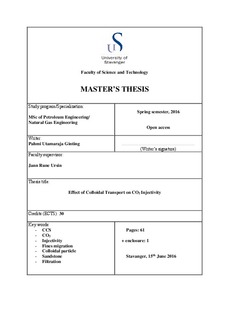| dc.description.abstract | Climate change is a long term change in weather due to Earth process, volcanic activity and change concentration of greenhouse gases such as carbon dioxide (CO2) in the atmosphere. CO2 is generated mainly from industrial or human activity. Carbon Capture & Storage (CCS) is an alternative technique to capture anthropogenic CO2, transport it to a suitable storage area, and finally store it safely and permanently in underground storage facilities. CO2 could also be stored by another storage method such as geological storage, ocean storage, and mineral storage.
The primary option to store captured CO2 is by injecting it into the geological storage in deep underground formation. Geological formation has great storage capacity to store huge amount of CO2 and seal it permanently. A good storage capacity in geological formation need to go along with high injectivity to store large amount of CO2. Also CO2 could be injected with much lower energy in high injectivity formation, saving energy as a result.
CO2 injection has several challenges. CO2 injectivity is never always constant in the operation. A decrease in CO2 injectivity waste energy and lower the efficiency. This injectivity loss is mainly caused by mineral precipitation, fines migration, and formation dry-out. Mineral precipitation and formation dry-out are mostly related to mineral or salt deposition inside formation, but fines migration is associated mineral dissolution.
Formation damage in subsurface porous media has been linked to fines migration. This formation damage induced by migratory fines takes place when fine particle travel together with reservoir fluid into the formation to reduce the flow channels and impair formation permeability and productivity. Therefore, fines migration could impair CO2 well injectivity. CO2 Injectivity loss could reduce the efficiency of CCS projects where large volumes of CO2 is injected into the reservoir for storage.
In this research, we investigated the impact of fines migration on CO2 injectivity. The influence of formation permeability, CO2 injection rate and fines concentration on injectivity loss are the main parameter in this work.
The fines migration process was reconstructed by saturating the formation rock with external colloidal particles followed by CO2 injection. Injection of stabilised colloidal particles into the reservoir rock has almost the same behaviour as fines migration process. Pressure drop profiles were monitored throughout the experiments to quantify the effect of these colloids on CO2 injectivity. Varying particle concentrations changes the pressure drop profiles. Low particle concentration tend to have flat pressure drop profile in saturated condition, high concentration tend to have increasing pressure profile showing there is more particle trapped inside the pore. This observation is also seen when particle size is increased. In some cases, filter cake has been observed. Permeability of the core is related to the size of the pore network. Low permeability core is characterized by narrow pore channels. The experiment shows that, in low permeability cores, pressure drop measured across the core is higher than in high permeability rock because of higher rate of entrapment of particle and filter cake formation.
CO2 injectivity measurement shows that higher concentration of particles in the saturating brine induces higher injectivity loss as more particles are trapped within the pore channels of the core. It was observed that large particle sizes induced lower injectivity loss because filter cake formed near the inlet and restrained more particle from entering the core, resulting in less permeability decline. This was also observed in low permeability cores where the pore channels favour filter cake formation. Low injectivity loss was recorded as a result. Effect of CO2 injection rate on colloidal transport and injectivity impairment was also investigated. The experimental results show that when CO2 injection rate increases, the injectivity loss also increases.
This thesis will provide basic understanding of the mechanisms of fines migration in reservoir and how it could affect CO2 injection and CCS operation as a whole. | nb_NO |
